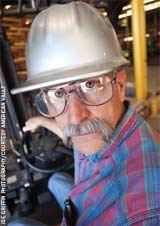
February 2009
- Safety's Blind Spot: Most Employers Ignore VIsion Testing
- Confined Spaces: Is Your Training Effective?
- Food Safety: FindingE. coli Faster
- AEDs & CPR: San Diego Leads the Way
Click here to subscribe.
Features
By Linda J. Sherrard
A posh hotel besieged with panicked employees running for their lives and commandos ringing the buildings. We saw this crisis unfold live; it reminds us that now is the time to refresh employees’ awareness of evacuation and preparedness procedures and their own roles. Do it now!

By Dan Napolitano
Business continuity, continuity of operations, and contingency planning are now everyday concepts. Crises both natural and manmade have forced businesses to recognize that preserving life and property must actively be a top priority. Recognizing the need for all organizations to communicate instantly and reliably during critical circumstances, Congress in July 2008 directed the Department of Homeland Security to develop the first National Emergency Communications Plan (NECP).
By Scott Coulter
Fact: Workplace safety in industrialized nations such as the United States, Canada, and much of the European Union is more entrenched than in other regions of the world. For ease of reference, we will call these advanced safety countries.
By Ronnie Rittenberry
For the fourth year in a row, EH&S, hazmat, fire, security, rescue, safety, and medical professionals from across the country will meet in Texas to heat up the house for the annual Industrial Fire, Safety & Security conference and exhibition.
By J. Stan Bailey
Imagine getting sick from eating a hamburger from your local fast food restaurant, or from consuming a supposedly healthy salad. Most consumers think that the food they buy from grocery stores or restaurants will be safe, but for the past 25 years this has not always been the case.
By Jim Madaffer
A handful of states and some countries, such as Japan, require automated external defibrillators (AEDs) in schools, in dental offices, or at gyms. And if your own organization takes employee health seriously, you likely have AEDs deployed at your workplace.

By William Margaretta, Barry R. Weissman
How many departments in your organization have requirements for visual inspections? How many of the codes, regulations, and legislative mandates demand that visual inspections be performed on a regular, weekly, monthly, quarterly, or annual basis? Think of the requirements for slings and wire ropes, aircraft parts, hazardous waste containers, and every commercial vehicle and load—the list goes on and on. Yet how many of those same codes have a single line that requires the inspectors (your employees) to be able to see and see correctly?
By Keshwar Anroedh
Confined spaces represent a major health and safety risk for many employees. Recognizing and planning appropriately for confined space work can mean the difference between a job well done and disaster.
By John W. Bannen
Entering and working in confined spaces is established as a hazardous activity, and effective training needs to be accomplished as a means to help protect employees from these hazards Some of the most frequently posed questions to consultants and training organizations have to do with what is needed in conducting training on this topic and how often the training is needed.
Departments
By Robert Pater
Every leader, manager, and safety professional I know hopes to see a higher level of worker awareness. But despite these wishes, there doesn’t seem to be a bull market in “awareness.” In fact, the opposite seems to hold. As external stressors pile on, people become more distracted, oftentimes so beset by personal worries—the economy? job security? retirement? effects on family relationships?—they have difficulty focusing even on simple day-in, day-out activities. So their default automatic pilot Safety programs become glitchy. And this doesn’t even begin to account for unusual events that really require split-second scoping out, decision-making, and immediate action.
By Kevin J. Zasada
Halfway through my bachelor’s degree in Environmental, Health, and Safety Management, I made the switch from Operations supervisor to Environmental, Health, and Safety Specialist. Through the course of the next two years, my view of the safety field as one that merely identifies hazards using OSHA and other tools made a 180-degree turn when I realized how versatile you have to be in order to be successful in safety.

By Ronnie Rittenberry
By and large, we don’t get around like we used to. Technology at work and home has made it so we don’t need to. Who remembers actually getting up and crossing the room to switch the channel or walking across the office to deliver a message to a co-worker? Since the advent of universal remotes and e-mail, such “activities” have come to seem downright inefficient or, at the very least, inconvenient. We can do so much now without ever having to leave our seats that, typically, we don’t. But remaining happily on our cushions is not without its repercussions.
By Jerry Laws
Where would we be without industrial hygiene? IH is the foundation of workplace safety and health, but without trustworthy, valid exposure limits that match the latest science about health effects, IH would be guesswork. That is a dangerous scenario in our time of swift global movement of new and recycled products, nanotechnologies, and new regulations meant to limit exposures of workers and the public to chemicals that can harm them.
By Marc Barrera
They’re not your average bikers. They don’t come roaring down the street in packs, polluting the air with loud noise and noxious exhaust gases. Instead of traffic rushing to make way for their passing, these bikers are constantly trying to negotiate their way around vehicles that refuse to share the road with them. They are bike messengers, and every day they perform a necessary service for little pay and no thanks in overpopulated cities that have become congested with stop-and-go traffic. But what attracts people to do this line of work?